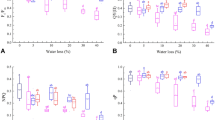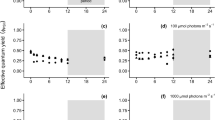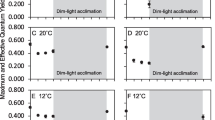Abstract
Pyropia yezoensis, belongs to the genus of Porphyra before 2011, inhabit on intertidal zone rocks where irradiation changes dramatically, implying that the seaweed has gained certain mechanisms to survive a harsh environment. Based on the photosynthetic parameters with or without the inhibitors determined by a Dual-PAM-100 apparatus, we investigated the photosynthetic performance and the changes in electron flow that occurred during the algae were stressed with different light intensities previously. When the irradiation saturation was approaching, the CEF around PS I became crucial since the addition of inhibitors usually led to an increase in non-photochemical quenching. The inhibitor experiments showed that there were at least three different CEF pathways in Py. yezoensis and these pathways compensated each other. In addition to maintaining a proper ratio of ATP/NAD(P)H to support efficient photosynthesis, the potential roles of CEF might also include the regulation of different photoprotective mechanisms in Py. yezoensis. Under the regulation of CEF, chlororespiration is thought to transport electrons from the reduced plastoquinone (PQ) pool to oxygen in order to mitigate the reduction in the electron transfer chain. When irradiation was up to the high-grade stress conditions, the relative value of CEF began to decrease, which implied that the NADP+ pool or PQ+ pool was very small and that the electrons were transferred from reduced PS I to oxygen. The scavenging enzymes might be activated and the water-water cycle probably became an effective means of removing the active oxygen produced by the irradiation stressed Py. yezoensis. We believe that the different mechanisms could make up the photoprotective network to allow Py. yezoensis for survival in a highly variable light stress habitat, which may enlighten scientists in future studies on irradiance stress in other algae species.
Similar content being viewed by others
Abbreviations
- LEF:
-
linear electron flow
- CEF:
-
cyclic electron flow
- PAR:
-
photosynthetic active radiation
- FNR:
-
ferredoxin: NADP+ reductase
- NDH:
-
NAD(P)H dehydrogenase
- PQ:
-
plastoquinone
- Cyt bf :
-
the cytochrome b 6 f complex
- Fd:
-
ferredoxin
- Y(ND):
-
non-photochemical quantum yields of PS I caused by donor-side limitation
- Y(NPQ):
-
quantum yield of regulated energy dissipation in PS II
References
Arnon D I, Chain R K. 1975. Regulation of ferredoxincatalyzed photosynthetic phosphorylations. Proceeding of the National Academy of Sciences of the United States of America, 72 (12): 4961–4965.
Asada K. 1999. The water-water cycle in Chloroplasts: scavenging of active oxygens and dissipation of excess photons. Annual Review of Plant Physiology and Plant Molecular Biology, 50: 601–639.
Baier M, Dietz K J. 1999. Alkylhydroperoxide reductases: the way out of the oxidative breakdown of lipids in chloroplasts. Trends in Plant Science, 4 (5): 166–168.
Bendall D S. 1982. Photosynthetic cytochromes of oxygenic organisms. Biochimica et Biophysica Acta (BBA)-Reviews on Bioenergetics, 683 (2): 119–151.
Bendall D S, Manasse R S. 1995. Cyclic photophosphorylation and electron transport. Biochimica et Biophysica Acta (BBA)-Bioenergetics, 1229 (1): 23–38.
Bennoun P. 1982. Evidence for a respiratory chain in the chloroplast. Proceeding of the National Academy of Sciences of the United States of America, 79 (14): 4352–4356.
Brooks M D, Sylak-Glaßsman E J, Fleming G R, Niyogi K K. 2013. A thioredoxin-like/β-propeller protein maintains the efficiency of light harvesting in Arabidopsis. Proceeding of the National Academy of Sciences of the United States of America, 110 (29): E2733–E2740.
Bukhov N, Carpentier R. 2004. Alternative photosystem I-driven electron transport routes: mechanisms and functions. Photosynthesis Research, 82 (1): 17–33.
Carol P, Stevenson D, Bisanz C, Breitenbach J, Sandmann G, Mache R, Coupland G, Kuntz M. 1999. Mutations in the Arabidopsis gene IMMUTANS cause a variegated phenotype by inactivating a chloroplast terminal oxidase associated with phytoene desaturation. The Plant Cell, 11 (1): 57–68.
Corneille S, Cournac L, Guedeney G, Havaux M, Peltier G. 1998. Reduction of the plastoquinone pool by exogenous NADH and NADPH in higher plant chloroplasts: characterization of a NAD(P)H-plastoquinone oxidoreductase activity. Biochimica et Biophysica Acta (BBA)-Bioenergetics, 1363 (1): 59–69.
Cournac L, Redding K, Bennoun P, Peltier G. 1997. Limited photosynthetic electron flow but no CO2 fixation in Chlamydomonas mutants lacking photosystem I. FEBS Let ters, 416 (1): 65–68.
Cournac L, Redding K, Ravenel J, Rumeau D, Josse E M, Kuntz M, Peltier G. 2000. Electron flow between photosystem II and oxygen in chloroplasts of photosystem I-deficient algae is mediated by a quinol oxidase involved in chlororespiration. J ournal of Biological C hemistry, 275 (23): 17256–17262.
Demmig-Adams B, Adams W W III. 1996. Xanthophyll cycle and light stress in nature: uniform response to excess direct sunlight among higher plant species. Planta, 198 (3): 460–470.
Endo T, Asada K. 1996. Dark induction of the nonphotochemical quenching of chlorophyll fluorescence by acetate in Chlamydomonas reinhardtii. Plant and Cell Physiology, 37 (4): 551–555.
Escoubas J M, Lomas M, LaRoche J, Falkowski P G. 1995. Light intensity regulation of caBgene transcription is signaled by the redox state of the plastoquinone pool. Proceeding of the National Academy of Sciences of the United States of America, 92 (22): 10237–10241.
Figueroa F L, Conde-Álvarez R, Gómez I. 2003. Relations between electron transport rates determined by pulse amplitude modulated chlorophyll fluorescence and oxygen evolution in macroalgae under different light conditions. Photosynthesis Research, 75 (3): 259–275.
Finazzi G, Johnson G N, Dall’Osto L, Zito F, Bonente G, Bassi R, Wollman F A. 2006. Nonphotochemical quenching of chlorophyll fluorescence in Chlamydomonas reinhardtii. Biochemistry, 45 (5): 1490–1498.
Fork D C, Herbert S K. 1993. Electron transport and photophosphorylation by photosystem I in vivo in plants and cyanobacteria. Photosynthesis Research, 36 (3): 149–168.
Foyer C H, Harbinson J. 1999. Relationships between antioxidant metabolism and carotenoids in the regulation of photosynthesis. In: Frank H A, Young A J, Britton G, Cogdell R J eds. The Photochemistry of Carotenoids. Kluwer Academic Publishers, Dordrecht. p.305–325.
Foyer C H, Bloom A J, Queval G, Noctor G. 2009. Photorespiratory metabolism: genes, mutants, energetics, and redox signaling. Annual Review of Plant Biology, 60: 455–484.
Gilmore A M, Björkman O. 1995. Temperature-sensitive coupling and uncoupling of ATPase-mediated, nonradiative energy dissipation: similarities between chloroplasts and leaves. Planta, 197 (4): 646–654.
Heber U, Walker D. 1992. Concerning a dual function of coupled cyclic electron transport in leaves. Plant Physiology, 100 (4): 1621–1626
Hideg É, Kálai T, Hideg K, Vass I. 1998. Photoinhibition of photosynthesis in vivo results in singlet oxygen production detection via nitroxide-induced fluorescence quenching in broad bean leaves. Biochemistry, 37 (33): 11405–11411.
Holt N E, Zigmantas D, Valkunas L, Li X P, Niyogi K K, Fleming G R. 2005. Carotenoid cation formation and the regulation of photosynthetic light harvesting. Science, 307 (5708): 433–436.
Horton P, Ruban A V, Walters R G. 1996. Regulation of light harvesting in green plants. Annual Review of Plant Physiology and Plant Molecular Biology, 47: 655–684.
Joliot P, Joliot A. 2002. Cyclic electron transfer in plant leaf. Proceeding of the National Academy of Sciences of the United States of America, 99 (15): 10209–10214.
Josse E M, Simkin A J, Gaffé J, Labouré A M, Kuntz M, Carol P. 2000. A plastid terminal oxidase associated with carotenoid desaturation during chromoplast differentiation. Plant Physiol ogy, 123 (4): 1427–1436.
Lesser M P. 1997. Oxidative stress causes coral bleaching during exposure to elevated temperatures. Coral Reefs, 16 (3): 187–192
Li Z R, Wakao S, Fischer BB, Niyogi K K. 2009. Sensing and responding to excess light. A nnual Review of Plant Biology, 60: 239–260.
Lin A P, Wang G C, Yang F, Pan G H. 2009. Photosynthetic parameters of sexually different parts of Porphyra katadai var. hemiphylla (Bangiales, Rhodophyta) during dehydration and re-hydration. Planta, 229 (4): 803–810.
Long S L, Humphries S, Falkowski P G. 1994. Photoinhibition of photosynthesis in nature. Annual Review of Plant Physiology and Plant Molecular Biology, 45: 633–662.
Lovelock C E, Winter K. 1996. Oxygen-dependent electron transport and protection from photoinhibition in leaves of tropical tree species. Planta, 198 (4): 580–587.
Maxwell D P, Laudenbach D E, Huner N P A. 1995. Redox regulation of light harvesting complex II and cab mRNA abundance in Dunaliella salina. Plant Physiology, 109 (3): 787–795.
Melis A. 1999. Photosystem-II damage and repair cycle in chloroplasts: what modulates the rate of photodamage in vivo? Trends in Plant Science, 4 (4): 130–135.
Müller P, Li X P, Niyogi K K. 2001. Non-photochemical quenching. A response to excess light energy. Plant Physiology, 125 (4): 1558–1566.
Neubauer C, Yamamoto H Y. 1992. Mehler-peroxidase reaction mediates zeaxanthin formation and zeaxathine-related fluorescence quenching in intact chloroplasts. Plant Physiology, 99 (4): 1354–1361.
Neubauer C, Yamamoto H Y. 1994. Membrane barriers and Mehler-peroxidase reaction limit the ascorbate available for violaxanthin de-epoxidase activity in intact chloroplasts. Photosynthesis Research, 39 (2): 139–147.
Nitschke U, Connan S, Stengel D B. 2012. Chlorophyll a fluorescence responses of temperate Phaeophyceae under submersion and emersion regimes: a comparison of rapid and steady-state light curves. Photosynthesis Research, 114 (1): 29–42.
Niyogi K K. 1999. Photoprotection revisited: genetic and molecular approaches. Annual Review of Plant Physiology and Plant Molecular Biology, 50: 333–359.
Niyogi K K. 2000. Safety valves for photosynthesis. Current Opinion in Plant Biology, 3 (6): 455–460
Pascal A A, Liu Z F, Broess K, van Oort B, van Amerongen H, Wang C, Horton P, Robert B, Chang W R, Ruban A. 2005. Molecular basis of photoprotection and control of photosynthetic light-harvesting. Nature, 436 (7047): 134–137.
Peltier G, Cournac L. 2002. Chlororespiration. Annual Review of Plant Biology, 53: 523–550.
Pfannschmidt T, Nilsson A, Allen J F. 1999. Photosynthetic control of chloroplast gene expression. Nature, 397 (6720): 625–628.
Porcar-Castell A, Juurola E, Nikinmaa E, Berninger F, Ensminger I, Hari P. 2008. Seasonal acclimation of photosystem II in Pinus sylvestris. I. Estimating the rate constants of sustained thermal energy dissipation and photochemistry. Tree Physiology, 28 (10): 1475–1482.
Ravenel J, Peltier G, Havaux M. 1994. The cyclic electron pathways around photosystem I in Chlamydomonas reinhardtii as determined in vivo by photoacoustic measurements of energy storage. Planta, 193 (2): 251–259.
Redding K, Cournac L, Vassiliev I R, Golbeck J H, Peltier G, Rochaix J D. 1999. Photosystem I is indispensable for photoautotrophic growth, CO2 fixation, and H2 photoproduction in Chlamydomonas reinhardtii. J ournal of Biological C hemistry, 274 (15): 10466–10473.
Ruban A V, Horton P. 1995. An investigation of the sustained component of nonphotochemical quenching of chlorophyll fluorescence in isolated chloroplasts and leaves of spinach. Plant Physiology, 108 (2): 721–726.
Ruuska S A, Badger M R, Andrews T J, von Caemmerer S. 2000. Photosynthetic electron sinks in transgenic tobacco with reduced amounts of Rubisco: little evidence for significant Mehler reaction. Journal of Experimental Botany, 51 (Suppl. 1): 357–368.
Schreiber U, Schliwa U, Bilger W. 1986. Continuous recording of photochemical and non-photochemical chlorophyll fluorescence quenching with a new type of modulation fluorometer. Photosynthesis Research, 10 (1-2): 51–62.
Schreiber U, Neubauer C. 1990. O2-dependent electron flow, membrane energization and the mechanism of nonphotochemical quenching of chlorophyll fluorescence. Photosynthesis Research, 25 (3): 279–293.
Schreiber U, Endo T, Mi H L, Asada K. 1995. Quenching analysis of chlorophyll fluorescence by saturation pulse method: particular aspects relating to the study of eukaryotic algae and cyanobacteria. Plant and Cell Physiology, 36 (5): 873–882.
Sutherland J E, Lindstrom S C, Nelson W A, Brodie J, Lynch M D J, Hwang M S, Choi H G, Miyata M, Kikuchi N, Oliveira M C, Farr T, Neefus C, Mols-Mortensen A, Milstein D, Müller K M. 2011. A new look at an ancient order: generic revision of the Bangiales (Rhodophyta). Journal of Phycology, 47 (5): 1131–1151.
Trebst A, Depka B. 1997. Role of carotene in the rapid turnover and assembly of photosystem II in Chlamydomonas reinhardtii. FEBS Letters, 400 (3): 359–362.
Verhoeven A S, Adams W W III, Demmig-Adams B. 1998. Two forms of sustained xanthophyll cycle-dependent energy dissipation in overwintering Euonymus kiautschovicus. Plant Cell and E nvironment, 21 (9): 893–903.
Verhoeven A S, Adams W W III, Demmig-Adams B. 1999. The xanthophyll cycle and acclimation of Pinus ponderosa and Malva neglecta to winter stress. Oecologia, 118 (3): 277–287.
Wu D Y, Wright D A, Wetzel C, Voytas D F, Rodermel S. 1999. The IMMUTANS variegation locus of Arabidopsis defines a mitochondrial alternative oxidase homolog that functions during early chloroplast biogenesis. Plant Cell, 11 (1): 43–55.
Yang D H, Webster J, Adam Z, Lindahl M, Andersson B. 1998. Induction of acclimative proteolysis of the light-harvesting chlorophyll a/b protein of photosystem II in response to elevated light intensities. Plant Physiology, 118 (3): 827–834.
Author information
Authors and Affiliations
Corresponding author
Additional information
Supported by the National Natural Science Foundation of China (No. 41176134), the Laboratory for Marine Biology and Biotechnology, Qingdao National Laboratory for Marine Science and Technology, the Prospective Joint Research Project of Jiangsu Province (No. BY2011188), the National Basic Research Program of China (973 Program) (No. 2011CB411908), and the National Marine Public Welfare Research Project (Nos. 201105023-8, 201105008-2)
Rights and permissions
About this article
Cite this article
Niu, J., Feng, J., Xie, X. et al. Involvement of cyclic electron flow in irradiance stress responding and its potential regulation of the mechanisms in Pyropia yezoensis . Chin. J. Ocean. Limnol. 34, 730–739 (2016). https://doi.org/10.1007/s00343-016-4236-9
Received:
Accepted:
Published:
Issue Date:
DOI: https://doi.org/10.1007/s00343-016-4236-9




